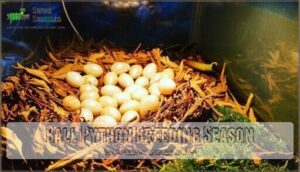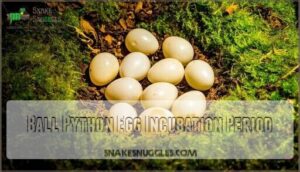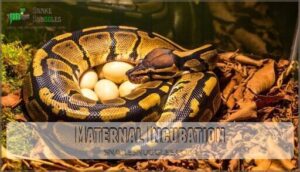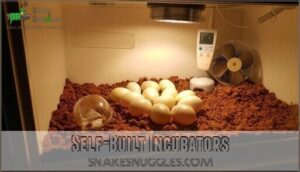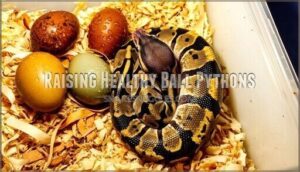This site is supported by our readers. We may earn a commission, at no cost to you, if you purchase through links.

First-time breeders often start smaller with 3-5 eggs, while experienced females can reach up to 11 eggs under ideal conditions.
The number depends on the snake’s age, size, health, and nutrition – think of it like a reproductive report card.
Survival rates vary markedly based on incubation conditions, with proper temperature (86-92°F) and humidity (80-90%) being vital factors.
Most eggs that receive adequate care will hatch successfully after 55-60 days, though some may fail due to genetic issues or improper environmental conditions, affecting their survival rates.
Table Of Contents
- Key Takeaways
- Ball Python Egg Clutch Size
- Ball Python Breeding Season
- Identifying a Gravid Ball Python
- Caring for Ball Pythons During Breeding
- Ball Python Egg Incubation Period
- Methods for Incubating Ball Python Eggs
- Essential Supplies for Ball Python Egg Incubation
- Ball Python Hatchling Survival Rates
- Raising Healthy Ball Pythons
- Frequently Asked Questions (FAQs)
- How many eggs do ball pythons lay?
- How often do pythons lay eggs?
- How many eggs do reticulated pythons lay?
- Are ball pythons good pets?
- Which Python lays the most eggs?
- What happens when Baby Ball pythons hatch?
- What snake lays 100 eggs?
- How many eggs give a snake in one time?
- How many eggs does a ball python lay?
- How long do ball pythons stay in their eggs?
- Conclusion
Key Takeaways
- You can expect 3-11 eggs per clutch from your ball python, with most females laying 5-7 eggs depending on their age, size, and health status.
- First-time breeders typically produce smaller clutches of 3-5 eggs, while experienced, well-nourished females can lay up to 11 eggs under optimal conditions.
- Proper incubation at 86-92°F with 80-90% humidity for 55-60 days is crucial – most eggs that receive adequate care will hatch successfully with survival rates of 80-95%.
- Your female’s reproductive success depends heavily on her being at least 2.5-3 years old, weighing 1,200-1,500 grams, and receiving proper nutrition during the breeding season.
Ball Python Egg Clutch Size
When you’re planning to breed ball pythons, you’ll want to know that females typically lay between 3 to 11 eggs per clutch, with most producing around 5 to 7 eggs.
Several factors influence how many eggs your snake will lay, including her age, size, health, and nutrition – think of it like how a well-fed, mature female is more likely to produce a larger clutch than a younger or smaller snake, considering her overall health.
A well-fed, mature female produces larger clutches than her younger, smaller counterparts – proper nutrition is the foundation of successful breeding
Average Number of Eggs Laid
A typical clutch size for ball pythons averages 5-7 eggs, though you’ll see variations based on key factors.
First-time breeders often produce smaller clutches of 3-5 eggs, while experienced females can lay up to 11 eggs under ideal conditions.
Here’s what influences ball python clutch size:
- Female age influence – Older females typically outperform younger ones
- Health status – Well-nourished pythons produce larger egg clutches
- Breeding timing – Peak season timing maximizes clutch variations
Your female’s individual genetics also play a role in determining her lifetime egg laying potential.
Factors Affecting Clutch Size
Several factors influence how many ball python eggs a female produces. Female health serves as the foundation – well-nourished pythons typically lay more eggs than those with poor diets or medical issues.
Age influence matters too, as mature females generally produce larger clutches than younger ones.
Nutrition impact during pre-breeding affects egg laying success, while optimal conditions including proper temperature and humidity maximize clutch size potential during breeding season.
Successful breeding also requires mimicking habitat cycles to stimulate reproductive behavior.
Maximum Number of Eggs Laid by a Female
Maximum ball python clutch size reaches 14 eggs under optimal conditions, though most females produce 4-10.
Exceptional clutches depend on female size, age, and genetic potential.
Larger, mature females consistently achieve higher egg laying success rates.
Key factors for maximum ball python reproduction:
- Female size and age directly influence egg clutch size
- Proper nutrition and environmental conditions boost clutch frequency
- Genetic potential varies between individual snakes
Ball Python Breeding Season
Timing matters when you’re planning to breed ball pythons.
In the wild, these African natives breed from mid-September to mid-November, but captive breeding typically happens from November to March when you can better control environmental conditions.
Wild Ball Python Breeding Season
Wild ball pythons time their python reproduction perfectly with nature’s rhythm. Seasonal Timing drives their breeding season from mid-September to mid-November, when Environmental Cues like increased rainfall trigger Natural Behaviors.
Habitat Influence guarantees Wild Success through strategic timing.
Key factors include:
- Abundant prey availability during rainy months
- Favorable temperatures for egg development
- Higher humidity levels protecting clutches
- Reduced predator activity increasing survival rates
Captive Ball Python Breeding Season
Captive ball python breeding typically runs November through March, contrasting with wild pythons’ September-November cycle.
Your captive environment lets you control breeding triggers like temperature drops and photoperiod changes.
Proper diet impact guarantees females store enough energy for reproduction.
Maintaining genetic diversity through ethical breeding practices protects your ball python eggs and supports healthy python reproduction in your snake breeding program.
| Breeding Factor | Captive Requirements |
|---|---|
| Temperature Drop | 75-78°F for 2-3 months |
| Photoperiod | 8-10 hours light daily |
| Humidity Level | 70-80% during breeding |
| Female Weight | Minimum 1,500 grams |
Mating and Courtship Behaviors
Male ball pythons initiate courtship by tail wagging and using cloacal spurs to tickle females, testing their receptiveness.
These courtship rituals trigger hormonal cycles that signal breeding cues. When ready, pairs lock together for 4-24 hours.
Females then exhibit maternal behavior, seeking cooler spots and wrapping around water bowls as follicles develop. Their dramatic color changes—called "glowing before they go"—indicate successful mating success during breeding season.
Captive breeding usually occurs during the September to March timeframe.
Identifying a Gravid Ball Python
Knowing when your ball python is carrying eggs can save you weeks of guesswork and help you prepare for the exciting hatching process.
You’ll spot several clear signs that indicate your female is gravid, from obvious physical changes to subtle shifts in her daily routine.
Age and Weight Requirements for Egg-Laying
Before you breed your ball python, she needs to meet specific age and weight milestones. Here’s your breeding checklist:
- Minimum Breeding Age: Wait until she’s at least 2.5-3 years old for ideal reproductive health
- Ideal Weight: Verify she weighs 1,200-1,500 grams before breeding attempts
- Health Implications: Underweight females may produce smaller first clutch sizes or experience complications
- Long-Term Fertility: Proper weight requirements support consistent ball python eggs production throughout her 25-year reproductive lifespan
Behavioral Changes in Gravid Ball Pythons
When your gravid python shows behavioral changes, you’ll notice reduced appetite and increased hiding behavior.
She’ll become more defensive, displaying territorial tendencies around her enclosure.
Nesting preparation kicks in as she searches for ideal laying spots, often circling or burrowing.
Posture changes become apparent – she may coil differently or rest in unusual positions.
These appetite shifts and nesting habits signal impending egg-laying, requiring careful observation and minimal disturbance during this sensitive period.
Physical Changes in Gravid Ball Pythons
Spotting a gravid python requires keen observation.
Physical changes include:
- Weight Gain – noticeable body mass increase
- Body Swelling – mid-section thickening and roundness
- Color Shift – skin becomes duller before prelay shed
- Appetite Increase followed by complete feeding refusal
- Palpation Methods reveal firm lumps when gently examined
These pregnancy signs help identify appetite shifts and reproductive readiness.
Caring for Ball Pythons During Breeding
Once your female ball python is confirmed gravid, you’ll need to adjust her care routine to support healthy egg development.
This means fine-tuning her environment, nutrition, and hydration levels to give both mom and her future babies the best chance at success.
Providing Proper Temperature and Humidity
Once you’ve identified your gravid ball python, creating the right environment becomes your top priority.
Temperature gradients and humidity monitoring work together to facilitate successful egg incubation and prevent complications.
- Maintain temperature gradients between 88-92°F in the basking area to support reproductive health
- Monitor humidity levels at 60-70% to prevent shedding issues and respiratory infections
- Use appropriate substrate that retains moisture while allowing proper ventilation
- Check conditions daily since fluctuations can dramatically impact ball python eggs survival rates
Maintaining a Balanced Diet
Proper nutrition becomes your python’s foundation for successful breeding, just like a well-tuned engine runs smoothly.
During breeding season, nutrient requirements shift dramatically as females prepare for egg development. Offer prey variety including appropriately-sized rodents every 10-14 days, avoiding supplementation needs unless veterinary-recommended.
Monitor body condition carefully for obesity prevention – overweight females often experience complications. Don’t panic if your snake refuses meals; it’s completely normal behavior during this period.
Focus on python feeding consistency rather than forcing meals. Quality ball python care means respecting their natural reptile diet variations while maintaining ideal body condition for reproduction success.
Ensuring Adequate Water and Hydration
Water and hydration keep your breeding female healthy during this demanding time. Water Quality matters – provide fresh, chlorine-free water in a bowl placed away from heat sources.
Monitor humidity levels between 50-60% using a reliable hygrometer. Watch for dehydration signs like sunken eyes or wrinkled skin, especially as temperature fluctuations affect Water Intake.
Proper Humidity Control supports both Snake Hydration and future Egg Hydration during incubation.
- Check water quality weekly and replace with dechlorinated water
- Position water bowls away from basking spots to prevent rapid evaporation
- Maintain consistent humidity through misting or larger water dishes
- Monitor your snake’s skin elasticity as a hydration indicator
Ball Python Egg Incubation Period
Once you’ve successfully bred your ball python, you’ll need to understand the incubation timeline to prepare for hatching.
The incubation period typically lasts 55 to 60 days at ideal temperatures, though this can extend up to 105 days depending on conditions and whether you’re using artificial or maternal incubation.
Average Incubation Time
Ball python eggs require approximately 55 to 60 days for complete egg development during the incubation period.
This incubation time stays consistent when you maintain temperature control between 86-92°F.
Your ball python eggs need steady humidity levels around 80-90% throughout their development.
Most egg clutch size variations won’t affect individual incubation time, and proper conditions typically yield hatch rates of 85-95%.
This two-month egg incubation timeline rarely varies substantially under ideal care.
Factors Affecting Incubation Time
Several key factors control how long your ball python eggs take to hatch. Temperature Control dominates the process—maintain 88°F to 92°F for ideal incubation time.
Higher temps speed things up, while cooler conditions slow development. Humidity Levels around 90-100% prevent egg dehydration during the incubation period.
Your Incubation Medium choice affects moisture retention, with vermiculite being ideal. Avoid Egg Turning completely—it kills embryos.
These variables work together, influencing your Hatch Rates and overall success with your egg clutch size. For optimal results, understanding python egg incubation is vital for ball python breeders.
Signs of Imminent Hatching
After weeks of careful incubation timing, you’ll notice exciting changes as your ball python eggs approach hatching.
Watching for these hatching signs helps you prepare for proper hatchling care during this critical egg development phase.
Here are the key indicators that your ball python eggs are ready to hatch:
- Egg tooth emergence – A small, sharp projection becomes visible through tiny slits in the shell
- Shell sagging – The once-firm eggshell begins to collapse and wrinkle as the embryo absorbs remaining fluids
- Gentle movement – You’ll see subtle shifting inside the eggs as hatchlings position themselves for emergence
- Reduced internal activity – After initial movement, activity decreases as babies conserve energy for hatching
- Temperature sensitivity – Eggs may feel slightly cooler as metabolic processes shift toward emergence
These signs typically appear within 24-48 hours before actual hatching begins.
During egg incubation’s final stage, resist the urge to handle or rotate eggs, as this can harm developing snakes.
Once hatching starts, the process takes 12-48 hours to complete naturally.
Methods for Incubating Ball Python Eggs
Once you’ve got fertilized eggs, you’ll need to choose how to incubate them for the best survival rates.
You can let the mother handle it naturally, invest in a commercial incubator, or build your own setup – each method has its own perks and challenges that’ll affect how many hatchlings make it, which is crucial for the hatchlings.
Maternal Incubation
Maternal incubation represents nature’s gold standard for ball python eggs. When your female coils around her clutch, she’s creating a living incubator that maintains temperatures between 88°F and 90°F through muscle contractions and positioning.
This female behavior showcases remarkable maternal care – she’ll abandon feeding for 50-60 days while providing clutch protection. The success of this method relies heavily on understanding optimal incubation conditions to guarantee healthy hatchlings.
Egg brooding offers several advantages over artificial methods:
The mother’s coiling creates ideal humidity through moisture retention while preventing egg incubation problems like fungal infections. Studies show maternal incubation methods achieve 90%+ hatch rates when environmental conditions remain stable.
Your snake basically becomes a temperature-regulating blanket, constantly adjusting to guarantee proper snake egg survival.
Commercial Incubators
Commercial incubators offer reliable temperature control and humidity management for ball python eggs. While maternal care works well, these devices provide consistent conditions that boost hatch rates.
Here are four key commercial incubator benefits:
- Automated Temperature Control – Maintains steady 88-92°F without manual adjustments
- Built-in Humidity Systems – Keeps moisture levels ideal for egg incubation
- Digital Monitoring – Track conditions remotely during the incubation period
- Higher Success Rates – Consistent environment improves snake egg survival
Popular brands like Hovabator deliver professional results for serious breeders. Reptile owners can research Ball Python Incubator options to find the best fit for their needs.
Self-Built Incubators
Building your own ball python egg incubator gives you complete control over the incubation process. These DIY setups can rival expensive commercial incubators when built correctly.
Start with an insulated cooler as your foundation. Add a reliable thermostat for precise temperature control and digital hygrometer for humidity management. Drill strategically-placed holes for your ventilation systems – too few and you’ll get stagnant air, too many and you’ll lose heat.
Here’s what you’ll need:
| Component | Purpose | Recommended Type |
|---|---|---|
| Thermostat | Temperature regulation | Digital with probe |
| Heat Source | Warming elements | Ceramic heat emitter |
| Fan | Air circulation | Computer cooling fan |
| Hygrometer | Humidity monitoring | Digital with probe |
Using a ball python incubator is vital for maintaining ideal conditions. Test your incubator design for 48 hours before trusting it with precious ball python eggs. Remember, egg turning isn’t necessary – these eggs naturally stick together and shouldn’t be rotated during the incubation period.
Essential Supplies for Ball Python Egg Incubation
Successfully incubating ball python eggs requires specific equipment to maintain proper temperature and humidity throughout the 55-60 day period.
You’ll need a reliable incubator, accurate monitoring devices, and appropriate containers with suitable substrate materials to give your eggs the best chance of hatching healthy babies.
Incubator Selection
Choosing the right incubator sets your ball python breeding success in motion.
Commercial incubators offer precise temperature control and humidity levels, maintaining that sweet spot of 88-90°F with built-in ventilation systems. You’ll find tabletop models perfect for small clutches or larger cabinet-style units for serious breeders.
DIY setups using modified coolers work just as well and won’t break the bank. Look for models with digital displays, automatic egg turning features, and reliable thermostats.
Size matters too—plan for 3-11 eggs per clutch, with room for expansion. Your incubator selection directly impacts the egg incubation process, so invest wisely in this foundational piece of equipment.
Hygrometer and Thermometer
Nobody wants their ball python eggs to become expensive snake jerky or soup.
You’ll need reliable environmental sensors to maintain precise temperature control (88-92°F) and humidity levels (70-90%). A quality hygrometer measures moisture while your thermometer tracks heat—both essential incubation tools for successful egg monitoring.
- Digital models with remote probes give accurate readings without opening the incubator
- Calibrated instruments prevent costly temperature fluctuations that kill embryos
- Dual-function devices save space while providing thorough environmental data
To achieve desirable results, understanding egg incubation basics is vital for maintaining the right conditions.
Egg Box and Substrate Options
Your egg box setup determines whether those ball python eggs develop into healthy hatchlings.
Select plastic containers with secure lids and drill small ventilation systems holes for airflow.
Substrate types like vermiculite or perlite work best – they’re moisture magnets that maintain perfect humidity control.
Mix your chosen substrate with water until it clumps slightly when squeezed.
Place your egg tray inside, ensuring reptile eggs stay snug but breathable during incubation.
For successful incubation, using an egg incubator is vital to maintain ideal conditions.
Ball Python Hatchling Survival Rates
When you’re hatching ball pythons, you’ll want to know how many babies actually make it out of the egg and thrive.
Survival rates can be high with proper care, but even the best snake parents can’t control every twist and turn—sometimes hatchlings just have their own plans, and proper care is crucial for their survival, with high survival rates possible.
Factors Affecting Hatchling Survival
Your hatchling’s survival depends on several critical environmental and genetic factors that you can control. Incubation temperature between 88-90°F and 90% humidity create ideal conditions for ball python eggs to develop properly.
Here’s what affects your hatchling survival rates:
- Temperature fluctuations below 88°F cause devastating deformities
- Humidity drops lead to deadly egg dehydration
- Poor genetics from inbred parents reduce viability by 50%
- Contaminated incubators spread fatal infections to developing embryos
- Nutritional deficiencies in parents create weak, fragile shells
Egg viability and neonate care determine whether your clutch size dreams become reality.
Common Causes of Mortality in Hatchlings
During their first weeks of life, several factors threaten hatchling survival rates dramatically.
Dehydration Risk and Feeding Refusal account for roughly 50% of early losses, while Respiratory Issues from poor ventilation double failure rates.
Navel Infections from improper yolk sac absorption cause sepsis by week three.
Temperature fluctuations during incubation reduce survival by 22%, and inadequate Hatchling Care leads to developmental problems.
Proper snake egg care prevents most mortality causes.
Tips for Improving Hatchling Survival
While previous issues can harm your clutch, you can substantially boost hatchling survival with smart incubation tips. Start with proper egg hydration – maintain 90% humidity to prevent desiccation. Your incubation setup should hold steady temperatures between 89-90°F for maximum hatch rates.
Neonate feeding begins after yolk absorption, typically within 10 days.
Key strategies for maximizing survival:
- Monitor ball python eggs daily for mold or damage
- Provide secure hides to reduce stress in hatchlings
- Use sterile substrates like paper towels for easy cleaning
- Track weight gain to confirm proper growth rates
- Start feeding attempts early with appropriately-sized prey
Raising Healthy Ball Pythons
Once you’ve successfully hatched your ball python eggs, you’ll need to focus on proper husbandry to guarantee these tiny serpents thrive in their new world.
Your hatchlings require specific care protocols including appropriate housing, feeding schedules, and health monitoring to maximize their survival rates during those critical first few months.
Providing Proper Care and Nutrition
After your python hatchlings emerge, proper Nutrient Balance becomes your top priority.
Establish a consistent Feeding Schedule with appropriately-sized prey every 5-7 days. Monitor Water Quality and maintain Humidity Control between 50-60% in their ball python habitat.
Dietary Supplements aren’t typically necessary for healthy python hatchlings, but focus on python growth through quality snake care practices.
Hatchling Nutrition
Dietary Needs
Feeding Schedule
Growth Rates
Monitoring Health and Growth
Tracking growth rates and conducting regular health checks guarantees your python hatchlings thrive.
Weigh them weekly using a digital scale to monitor weight management and development patterns.
Watch for consistent shedding cycles, clear eyes, and active behavior—these indicate proper snake health.
Establish structured nutrition plans with appropriately sized prey items to support steady growth and long-term python survival.
Addressing Common Health Issues
Monitoring your python’s wellbeing helps catch problems before they become serious.
Watch for these concerning signs that require immediate attention:
- Dehydration Risk – Wrinkled skin and sunken eyes signal urgent hydration needs
- Respiratory Issues – Mouth breathing or wheezing indicates potential respiratory infections
- Feeding Refusal – Extended appetite loss often precedes other hatchling diseases
Address shedding problems with proper humidity, prevent parasite prevention through clean habitats, and monitor for navel infections in young snakes.
Frequently Asked Questions (FAQs)
How many eggs do ball pythons lay?
Like nature’s lottery ticket, you’ll find ball pythons typically lay 4-10 eggs per clutch, with most females producing around 5-6 eggs.
Larger, older females often lay more eggs than younger ones.
How often do pythons lay eggs?
Female ball pythons typically lay eggs once yearly during their breeding season, which runs from November through March in captivity and fall months in the wild.
How many eggs do reticulated pythons lay?
Reticulated pythons lay 15-107 eggs per clutch, with larger females producing more eggs.
Most females typically lay 20-40 eggs, while exceptionally large females can exceed
You’ll find their clutch size depends heavily on the snake’s body size.
These snakes are native to southeastern Asia, which is a key factor in understanding their native habitats.
Are ball pythons good pets?
Ball pythons make excellent pets for beginners and experienced keepers alike. You’ll appreciate their docile nature, manageable size, and calm temperament that makes handling enjoyable and stress-free for everyone.
Which Python lays the most eggs?
In the context of egg-laying champions, you’re looking at a numbers game where size truly matters.
Reticulated pythons hold the crown, laying 20-100 eggs per clutch, while Burmese pythons follow with 12-36 eggs.
Dwarfing ball pythons’ modest 3-11 eggs is a significant difference, showcasing the varying numbers in egg-laying capabilities among these species.
What happens when Baby Ball pythons hatch?
When your baby ball pythons hatch, they’ll spend over 24 hours slowly emerging while absorbing their yolk sac for energy.
You’ll need to set up separate enclosures and start feeding them small prey like crickets within ten days.
What snake lays 100 eggs?
Like a fish laying thousands of eggs to guarantee some survive, pythons take a different approach.
You won’t find a snake that consistently lays 100 eggs—most species produce far fewer, typically ranging from just a few to several dozen eggs per clutch.
This approach is distinct, highlighting the difference in reproductive strategies between species.
How many eggs give a snake in one time?
You’ll find that snake clutch sizes vary dramatically by species.
Ball pythons typically lay 4-10 eggs per clutch, while some species like reticulated pythons can produce 15-80 eggs at once, depending on their size and health, which showcases a significant difference in clutch sizes.
How many eggs does a ball python lay?
Ball pythons typically lay 4-6 eggs per clutch, though they can produce anywhere from 3-11 eggs.
You’ll find larger, older females often lay more eggs than younger ones.
About 80-95% of properly incubated eggs successfully hatch.
How long do ball pythons stay in their eggs?
Your ball python eggs take about 55-60 days to hatch at proper temperatures around 88-90°F.
You’ll notice the incubation period can stretch slightly longer, but most healthy eggs complete development within two months under ideal conditions.
Conclusion
Understanding how many eggs do ball pythons lay and how many survive is like having a roadmap for successful breeding.
You’ll typically see 3-11 eggs per clutch, with first-time mothers producing fewer eggs than experienced females. Your snake’s age, size, and health directly impact clutch size, while proper incubation conditions determine survival rates.
With correct temperature and humidity, most eggs hatch successfully after 55-60 days. Remember, patience and attention to detail make all the difference in achieving healthy hatchlings.
- https://www.ncbi.nlm.nih.gov/pmc/articles/PMC6021098/
- https://www.wilbanksreptiles.com/blogs/ball-pythons/a-complete-guide-to-albino-ball-pythons-wilbanks-reptiles
- https://medium.com//maternal-incubation-natures-way-5194b6ccfe6b
- https://link.springer.com/article/10.1007/BF00693366
- http://www.evolutionary-ecology.com/issues/v07n05/iiar1858.pdf

